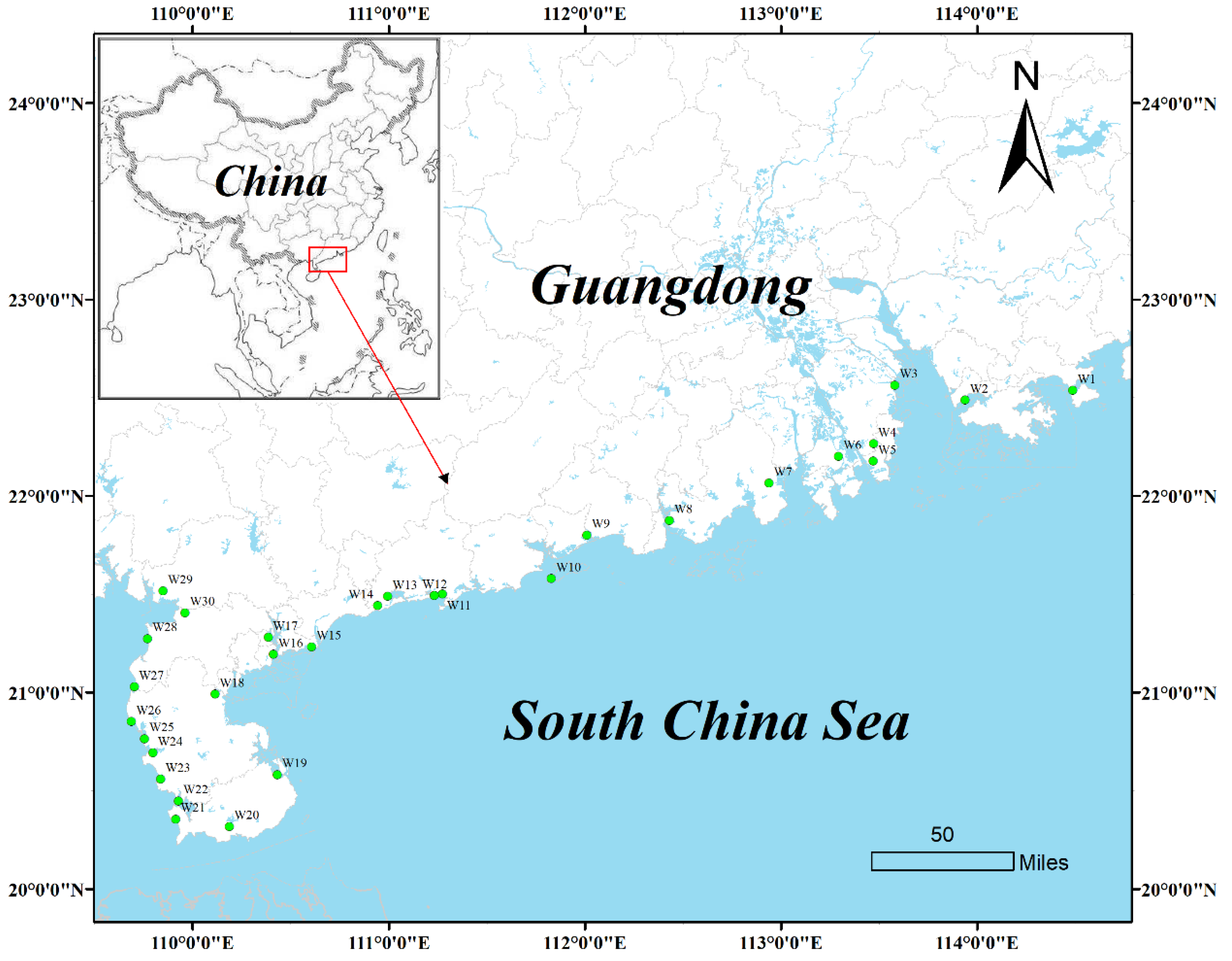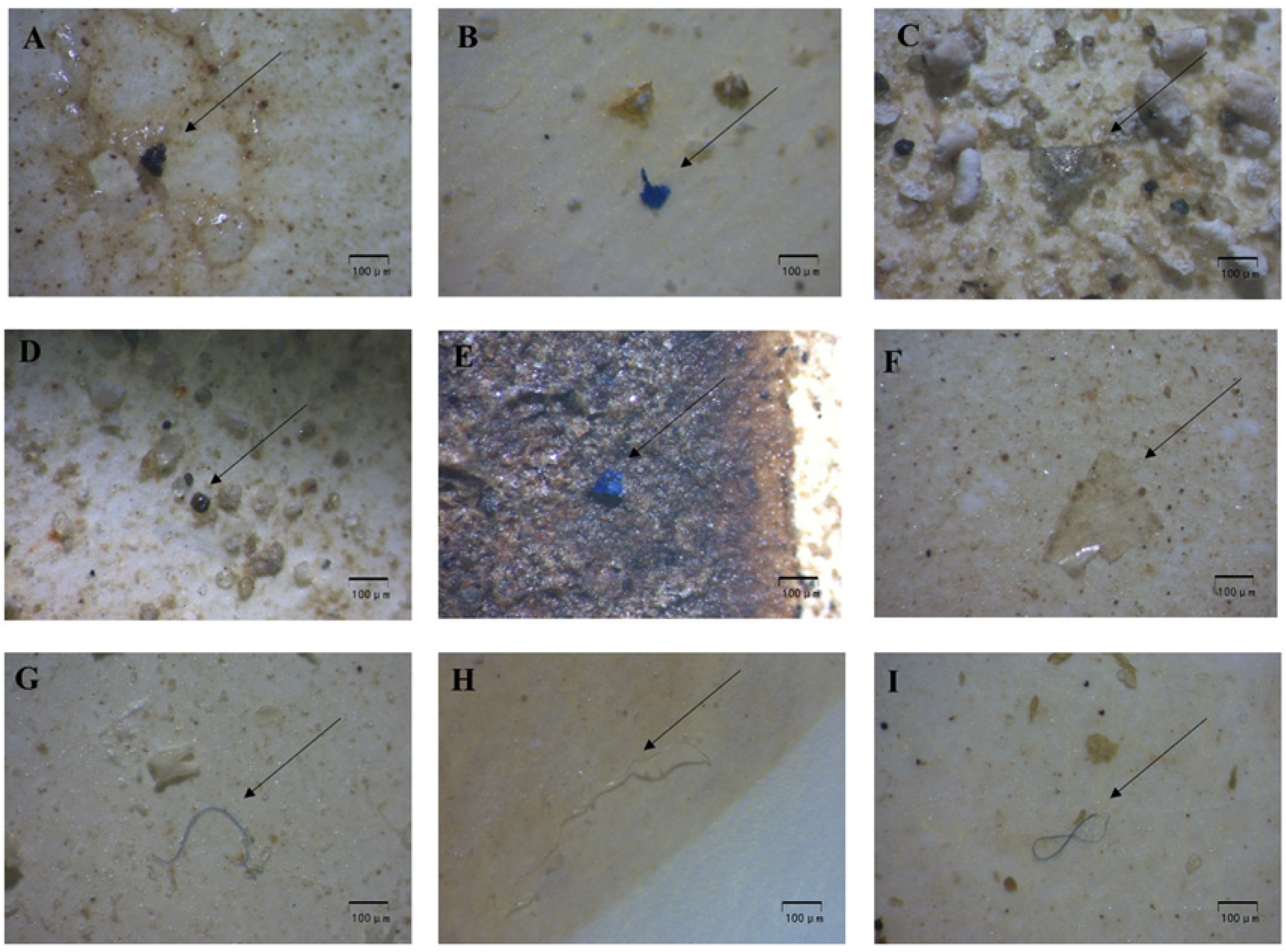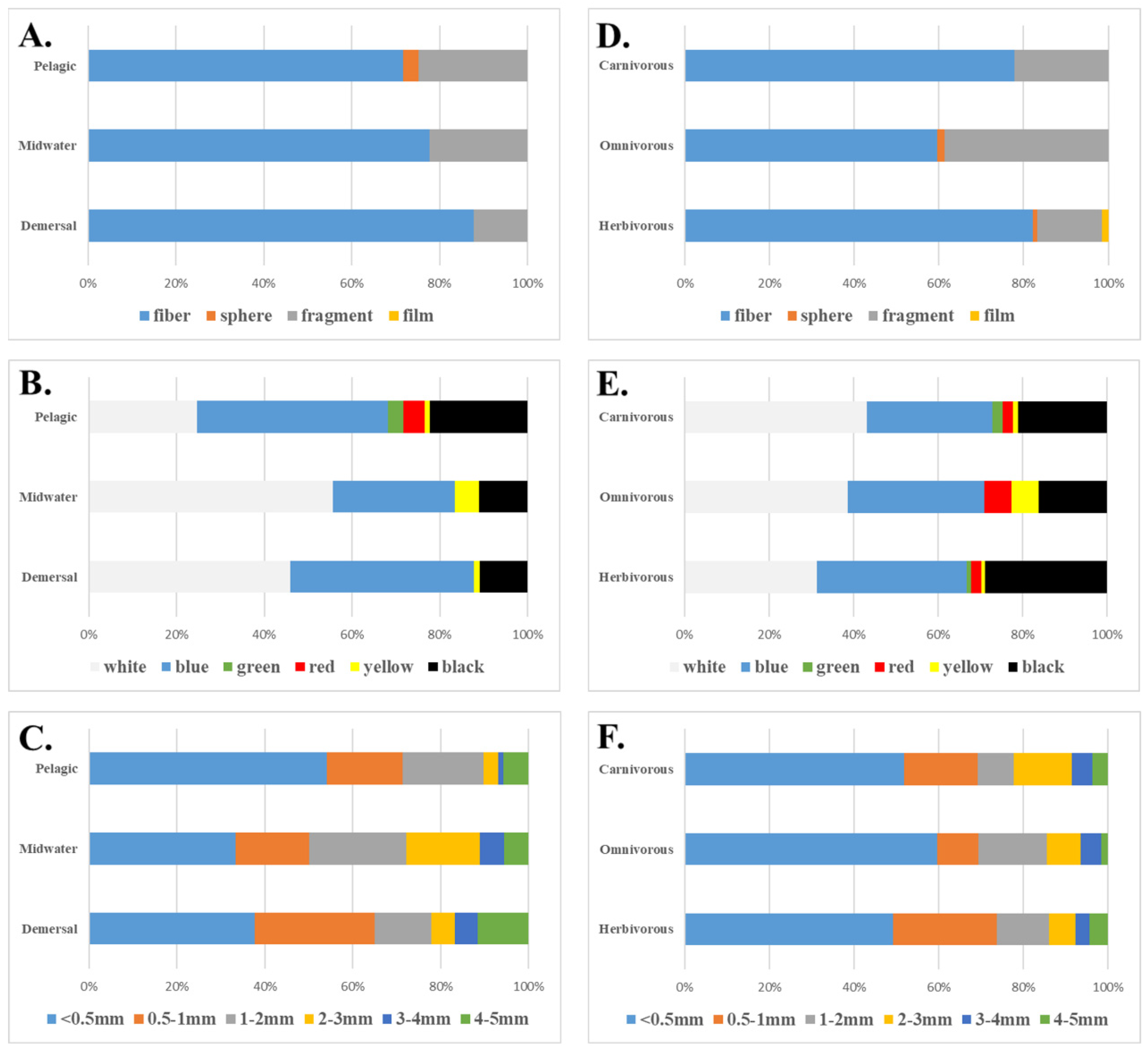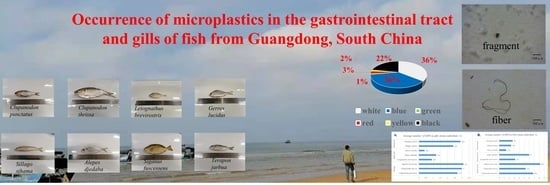Occurrence of Microplastics in the Gastrointestinal Tract and Gills of Fish from Guangdong, South China
Abstract
:1. Introduction
2. Materials and Methods
2.1. Sampling
2.2. Microplastic Extraction
2.3. Microscopy
2.4. Quality Assurance and Control
2.5. Statistical Analysis
3. Results
3.1. Microplastics in Fish
3.2. Characteristics of Microplastics in the Gills of Fish from Different Habitats
3.3. Characteristics of Microplastics in the GIT of Fish from Different Feeding Habits
3.4. Characteristics of Microplastics in Fish Isolated from Three Regions
4. Discussion
4.1. Characteristics of the Microplastics in Fish
4.2. Microplastics in the Different Feeding Habits and Different Habitats of Fish
5. Conclusions
Supplementary Materials
Author Contributions
Funding
Institutional Review Board Statement
Informed Consent Statement
Data Availability Statement
Conflicts of Interest
References
- Sun, J.; Xia, S.; Yan, N.; Xia, P.; Qu, J.; Xu, Y. Effects of microplastics and attached heavy metals on growth, immunity, and heavy metal accumulation in the yellow seahorse, Hippocampus kuda Bleeker. Mar. Pollut. Bull. 2019, 149, 110510. [Google Scholar] [CrossRef] [PubMed]
- Zhang, S.; Liu, F. The distribution of microplastics in soil aggregate fractions in southwestern China. Sci. Total Environ. 2018, 642, 12–20. [Google Scholar] [CrossRef] [PubMed]
- Tata, T.; Belabed, B.E.; Bououdina, M.; Bellucci, S. Occurrence and characterization of surface sediment microplastics and litter from North African coasts of Mediterranean Sea: Preliminary research and first evidence. Sci. Total Environ. 2020, 713, 136664. [Google Scholar] [CrossRef]
- Xu, P.; Peng, G.; Su, L.; Gao, Y.; Gao, L.; Li, D. Microplastic risk assessment in surface waters: A case study in the Changjiang Estuary, China. Mar. Pollut. Bull. 2018, 133, 647–654. [Google Scholar] [CrossRef]
- Felismino, M.E.L.; Helm, P.A.; Rochman, C.M. Microplastic and other anthropogenic microparticles in water and sediments of Lake Simcoe. J. Great Lakes Res. 2021, 47, 180–189. [Google Scholar] [CrossRef]
- Almeda, R.; Rodriguez-Torres, R.; Rist, S.; Winding, M.; Stief, P.; Hansen, B.; Nielsen, T.G. Microplastics do not increase bioaccumulation of petroleum hydrocarbons in Arctic zooplankton but trigger feeding suppression under co-exposure conditions. Sci. Total Environ. 2021, 751, 141264. [Google Scholar] [CrossRef]
- Pegado, T.D.S.E.; Schmid, K.; Winemiller, K.O.; Chelazzi, D.; Cincinelli, A.; Dei, L.; Giarrizzo, T. First evidence of microplastic ingestion by fishes from the Amazon River estuary. Mar. Pollut. Bull. 2018, 133, 814–821. [Google Scholar] [CrossRef]
- Hipfner, J.M.; Galbraith, M.; Tucker, S.; Studholme, K.R.; Domalik, A.D.; Pearson, S.F.; Good, T.P.; Ross, P.S.; Hodum, P. Two forage fishes as potential conduits for the vertical transfer of microfibres in Northeastern Pacific Ocean food webs. Environ. Pollut. 2018, 239, 215–222. [Google Scholar] [CrossRef]
- Morgana, S.; Ghigliotti, L.; Estévez-Calvar, N.; Stifanese, R.; Wieczorek, A.; Doyle, T.; Christiansen, J.S.; Faimali, M.; Garaventa, F. Microplastics in the Arctic: A case study with sub-surface water and fish samples off Northeast Greenland. Environ. Pollut. 2018, 242, 1078–1086. [Google Scholar] [CrossRef]
- Kosuth, M.; Mason, S.A.; Wattenberg, E.V. Anthropogenic contamination of tap water, beer, and sea salt. PLoS ONE 2018, 13, e0194970. [Google Scholar] [CrossRef]
- Hadri, H.E.; Gigault, J.; Maxit, B.; Grassl, B.; Reynaud, S. Nanoplastic from mechanically degraded primary and secondary microplastics for environmental assessments. Nanoimpact 2020, 17, 100206. [Google Scholar] [CrossRef]
- Fu, Z.; Wang, J. Current practices and future perspectives of microplastic pollution in freshwater ecosystems in China. Sci. Total Environ. 2019, 691, 697–712. [Google Scholar] [CrossRef]
- Auta, H.; Emenike, C.; Fauziah, S. Distribution and importance of microplastics in the marine environment: A review of the sources, fate, effects, and potential solutions. Environ. Int. 2017, 102, 165–176. [Google Scholar] [CrossRef]
- Baechler, B.R.; Granek, E.F.; Hunter, M.V.; Conn, K.E. Microplastic concentrations in two Oregon bivalve species: Spatial, temporal, and species variability. Limnol. Oceanogr. Lett. 2020, 5, 54–65. [Google Scholar] [CrossRef]
- Lusher, A.L.; Hernandez-Milian, G.; Berrow, S.; Rogan, E.; O’Connor, I. Incidence of marine debris in cetaceans stranded and bycaught in Ireland: Recent findings and a review of historical knowledge. Environ. Pollut. 2018, 232, 467–476. [Google Scholar] [CrossRef] [PubMed]
- Rist, S.; Vianello, A.; Winding, M.H.S.; Nielsen, T.G.; Almeda, R.; Torres, R.R.; Vollertsen, J. Quantification of plankton-sized microplastics in a productive coastal Arctic marine ecosystem. Environ. Pollut. 2020, 266, 115248. [Google Scholar] [CrossRef] [PubMed]
- Suami, R.B.; Sivalingam, P.; Al Salah, D.M.; Grandjean, D.; Mulaji, C.K.; Mpiana, P.T.; Breider, F.; Otamonga, J.-P.; Poté, J. Heavy metals and persistent organic pollutants contamination in river, estuary, and marine sediments from Atlantic Coast of Democratic Republic of the Congo. Environ. Sci. Pollut. Res. 2020, 27, 20000–20013. [Google Scholar] [CrossRef]
- Kolandhasamy, P.; Su, L.; Li, J.; Qu, X.; Jabeen, K.; Shi, H. Adherence of microplastics to soft tissue of mussels: A novel way to uptake microplastics beyond ingestion. Sci. Total Environ. 2018, 610–611, 635–640. [Google Scholar] [CrossRef] [PubMed]
- Ateia, M.; Zheng, T.; Calace, S.; Tharayil, N.; Pilla, S.; Karanfil, T. Sorption behavior of real microplastics (MPs): Insights for organic micropollutants adsorption on a large set of well-characterized MPs. Sci. Total Environ. 2020, 720, 137634. [Google Scholar] [CrossRef]
- Jabeen, K.; Su, L.; Li, J.; Yang, D.; Tong, C.; Mu, J.; Shi, H. Microplastics and mesoplastics in fish from coastal and fresh waters of China. Environ. Pollut. 2017, 221, 141–149. [Google Scholar] [CrossRef]
- Renzi, M.; Guerranti, C.; Blašković, A. Microplastic contents from maricultured and natural mussels. Mar. Pollut. Bull. 2018, 131, 248–251. [Google Scholar] [CrossRef] [PubMed]
- Usman, S.; Razis, A.F.A.; Shaari, K.; Amal, M.N.A.; Saad, M.Z.; Isa, N.M.; Nazarudin, M.F.; Zulkifli, S.Z.; Sutra, J.; Ibrahim, M.A. Microplastics Pollution as an Invisible Potential Threat to Food Safety and Security, Policy Challenges and the Way Forward. Int. J. Environ. Res. Public Health 2020, 17, 9591. [Google Scholar] [CrossRef] [PubMed]
- Battaglia, P.; Pedà, C.; Musolino, S.; Esposito, V.; Andaloro, F.; Romeo, T. Diet and first documented data on plastic ingestion ofTrachinotus ovatusL. 1758 (Pisces: Carangidae) from the Strait of Messina (central Mediterranean Sea). Ital. J. Zool. 2015, 83, 121–129. [Google Scholar] [CrossRef]
- Romeo, T.; Pietro, B.; Pedà, C.; Consoli, P.; Andaloro, F.; Fossi, M.C. First evidence of presence of plastic debris in stomach of large pelagic fish in the Mediterranean Sea. Mar. Pollut. Bull. 2015, 95, 358–361. [Google Scholar] [CrossRef]
- Murphy, F.; Russell, M.; Ewins, C.; Quinn, B. The uptake of macroplastic & microplastic by demersal & pelagic fish in the Northeast Atlantic around Scotland. Mar. Pollut. Bull. 2017, 122, 353–359. [Google Scholar] [PubMed] [Green Version]
- FAO. Food and Agriculture Organization of the United Nations: Contributing to Food Security and Nutrition for All; FAO: Rome, Italy, 2016; p. 190. ISBN 978-92-5-109185-2. [Google Scholar]
- Ma, J.; Niu, X.; Zhang, D.; Lu, L.; Ye, X.; Deng, W.; Li, Y.; Lin, Z. High levels of microplastic pollution in aquaculture water of fish ponds in the Pearl River Estuary of Guangzhou, China. Sci. Total Environ. 2020, 744, 140679. [Google Scholar] [CrossRef]
- Zhang, C.; Wang, S.; Pan, Z.; Sun, D.; Xie, S.; Zhou, A.; Wang, J.; Zou, J. Occurrence and distribution of microplastics in commercial fishes from estuarine areas of Guangdong, South China. Chemosphere 2020, 260, 127656. [Google Scholar] [CrossRef]
- Zheng, K.; Fan, Y.; Zhu, Z.; Chen, G.; Tang, C.; Peng, X. Occurrence and Species-Specific Distribution of Plastic Debris in Wild Freshwater Fish from the Pearl River Catchment, China. Environ. Toxicol. Chem. 2019, 38, 1504–1513. [Google Scholar] [CrossRef]
- Wang, S.; Zhang, C.; Pan, Z.; Sun, D.; Zhou, A.; Xie, S.; Wang, J.; Zou, J. Microplastics in wild freshwater fish of different feeding habits from Beijiang and Pearl River Delta regions, south China. Chemosphere 2020, 258, 127345. [Google Scholar] [CrossRef]
- Zhu, L.; Wang, H.; Chen, B.; Sun, X.; Qu, K.; Xia, B. Microplastic ingestion in deep-sea fish from the South China Sea. Sci. Total Environ. 2019, 677, 493–501. [Google Scholar] [CrossRef]
- Koongolla, J.B.; Lin, L.; Pan, Y.-F.; Yang, C.-P.; Sun, D.-R.; Liu, S.; Xu, X.-R.; Maharana, D.; Huang, J.-S.; Li, H.-X. Occurrence of microplastics in gastrointestinal tracts and gills of fish from Beibu Gulf, South China Sea. Environ. Pollut. 2020, 258, 113734. [Google Scholar] [CrossRef] [PubMed]
- Zhang, D.; Cui, Y.; Zhou, H.; Jin, C.; Yu, X.; Xu, Y.; Li, Y.; Zhang, C. Microplastic pollution in water, sediment, and fish from artificial reefs around the Ma’an Archipelago, Shengsi, China. Sci. Total Environ. 2020, 703, 134768. [Google Scholar] [CrossRef] [PubMed]
- Isobe, A.; Uchida, K.; Tokai, T.; Iwasaki, S. East Asian seas: A hot spot of pelagic microplastics. Mar. Pollut. Bull. 2015, 101, 618–623. [Google Scholar] [CrossRef] [PubMed]
- Su, L.; Deng, H.; Li, B.; Chen, Q.; Pettigrove, V.; Wu, C.; Shi, H. The occurrence of microplastic in specific organs in commercially caught fishes from coast and estuary area of east China. J. Hazard. Mater. 2019, 365, 716–724. [Google Scholar] [CrossRef]
- Park, T.-J.; Lee, S.-H.; Lee, M.-S.; Lee, J.-K.; Lee, S.-H.; Zoh, K.-D. Occurrence of microplastics in the Han River and riverine fish in South Korea. Sci. Total Environ. 2020, 708, 134535. [Google Scholar] [CrossRef]
- Feng, Z.; Zhang, T.; Li, Y.; He, X.; Wang, R.; Xu, J.; Gao, G. The accumulation of microplastics in fish from an important fish farm and mariculture area, Haizhou Bay, China. Sci. Total Environ. 2019, 696, 133948. [Google Scholar] [CrossRef]
- Jovanović, B.; Gökdağ, K.; Güven, O.; Emre, Y.; Whitley, E.M.; Kideys, A.E. Virgin microplastics are not causing imminent harm to fish after dietary exposure. Mar. Pollut. Bull. 2018, 130, 123–131. [Google Scholar] [CrossRef] [Green Version]
- Wang, T.; Li, B.; Zou, X.; Wang, Y.; Li, Y.; Xu, Y.; Mao, L.; Zhang, C.; Yu, W. Emission of primary microplastics in mainland China: Invisible but not negligible. Water Res. 2020, 162, 214–224. [Google Scholar] [CrossRef] [PubMed]





| Species | Living Habitats | Feeding Habitats | Number of Fish | Body Length (cm) | Wet Weight (g) | Number of MPs | Average (Items Individual−1) |
|---|---|---|---|---|---|---|---|
| Clupanodon punctatus | Pelagic | Herbivorous | 9 | 13.6 ± 1.74 | 47.3 ± 15.12 | 85 | 9.4 |
| Clupanodon thrissa | Pelagic | Herbivorous | 6 | 17.8 ± 3.03 | 92.3 ± 38.93 | 50 | 8.3 |
| Siganus fuscessens | Pelagic | Herbivorous | 14 | 12.7 ± 1.74 | 46.6 ± 23.44 | 158 | 11.3 |
| Leiognathus brevirostris | Midwater | Omnivorous | 10 | 7.8 ± 0.88 | 11.5 ± 4.08 | 41 | 4.1 |
| Alepes djedaba | Midwater | Omnivorous | 5 | 11.2 ± 1.61 | 21.8 ± 7.63 | 36 | 7.2 |
| Gerres lucidus | Midwater | Carnivorous | 7 | 8.1 ± 1.48 | 14.3 ± 7.43 | 13 | 1.9 |
| Sillago sihama | Demersal | Carnivorous | 15 | 12.4 ± 1.76 | 18.9 ± 8.57 | 72 | 4.8 |
| Terapon jarbua | Demersal | Carnivorous | 14 | 11.3 ± 1.42 | 34.5 ± 14.16 | 73 | 5.2 |
Publisher’s Note: MDPI stays neutral with regard to jurisdictional claims in published maps and institutional affiliations. |
© 2021 by the authors. Licensee MDPI, Basel, Switzerland. This article is an open access article distributed under the terms and conditions of the Creative Commons Attribution (CC BY) license (https://creativecommons.org/licenses/by/4.0/).
Share and Cite
Pan, Z.; Zhang, C.; Wang, S.; Sun, D.; Zhou, A.; Xie, S.; Xu, G.; Zou, J. Occurrence of Microplastics in the Gastrointestinal Tract and Gills of Fish from Guangdong, South China. J. Mar. Sci. Eng. 2021, 9, 981. https://doi.org/10.3390/jmse9090981
Pan Z, Zhang C, Wang S, Sun D, Zhou A, Xie S, Xu G, Zou J. Occurrence of Microplastics in the Gastrointestinal Tract and Gills of Fish from Guangdong, South China. Journal of Marine Science and Engineering. 2021; 9(9):981. https://doi.org/10.3390/jmse9090981
Chicago/Turabian StylePan, Zhengkun, Chaonan Zhang, Shaodan Wang, Di Sun, Aiguo Zhou, Shaolin Xie, Guohuan Xu, and Jixing Zou. 2021. "Occurrence of Microplastics in the Gastrointestinal Tract and Gills of Fish from Guangdong, South China" Journal of Marine Science and Engineering 9, no. 9: 981. https://doi.org/10.3390/jmse9090981
APA StylePan, Z., Zhang, C., Wang, S., Sun, D., Zhou, A., Xie, S., Xu, G., & Zou, J. (2021). Occurrence of Microplastics in the Gastrointestinal Tract and Gills of Fish from Guangdong, South China. Journal of Marine Science and Engineering, 9(9), 981. https://doi.org/10.3390/jmse9090981








